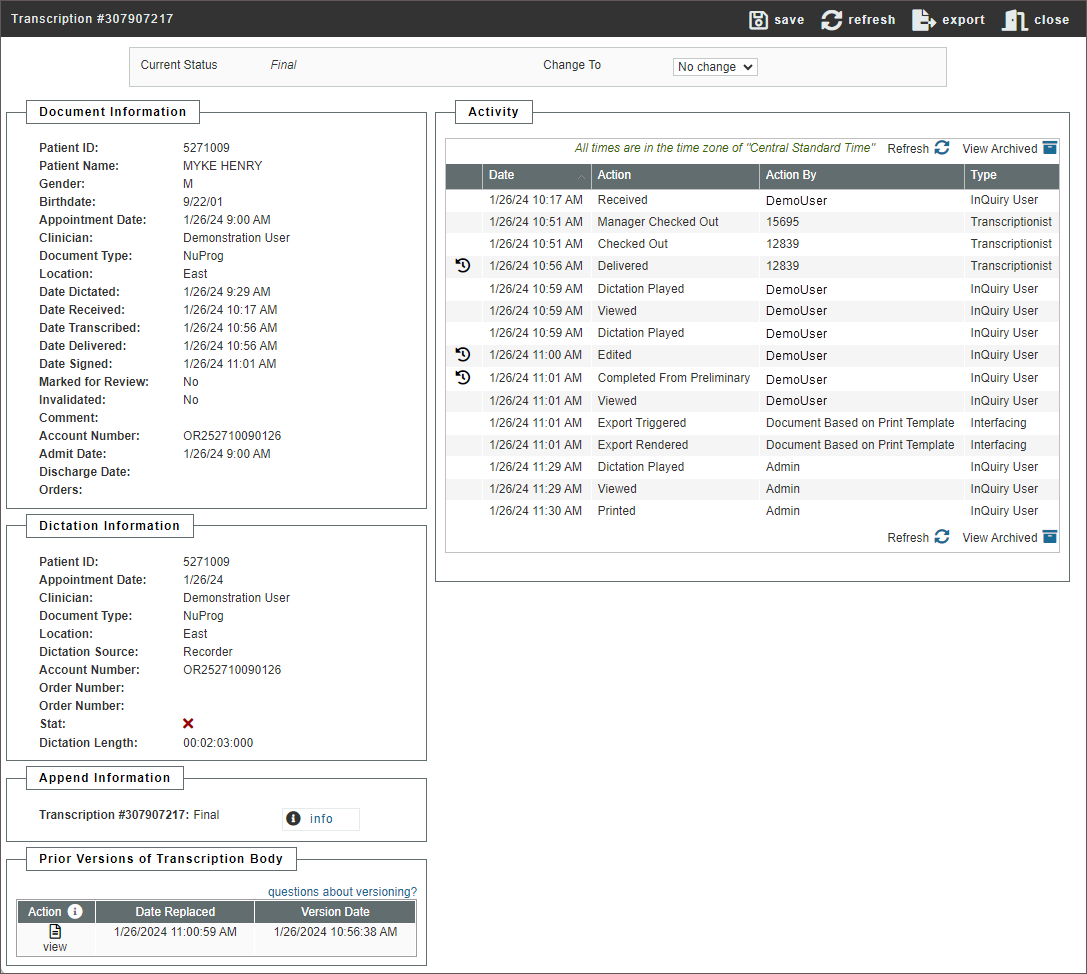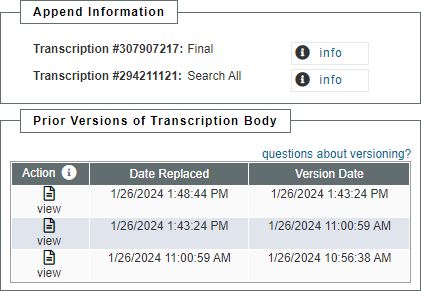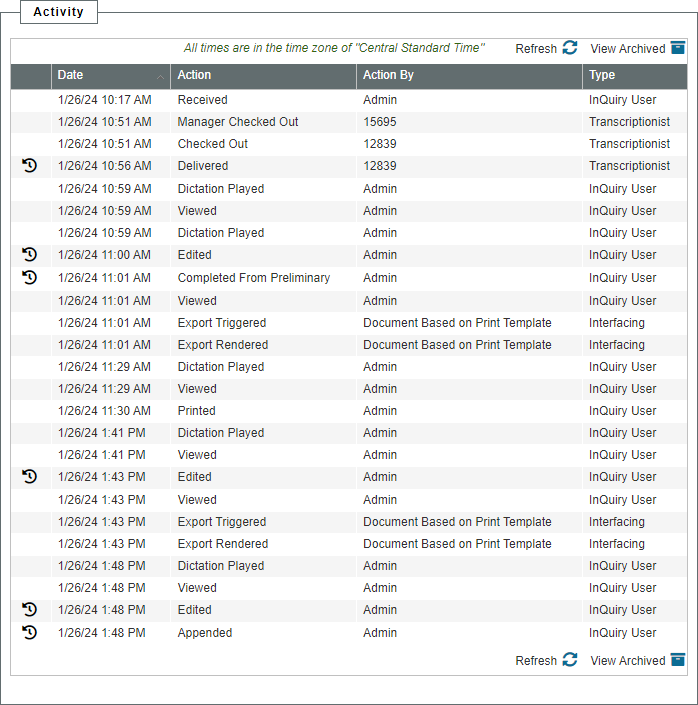Transcription Information¶
Transcription Information contains details pertinent to the transcription. It also allows users with access rights to move a transcription back to a previous stage in the workflow or to invalidate unwanted transcriptions.
Transcription information can be opened from the transcription viewer by using the  Info button and by selecting View Info from the Actions menu in the data grid.
Info button and by selecting View Info from the Actions menu in the data grid.

Refresh, Export and Close¶
These buttons are available at the top right corner of the Transcription Information window.
- Save will save changes to the status of the transcription. This button only appears after a change has been made.
- Refresh will reload the transcription data.
- Export will allow the user to manually export the transcription if it meets the criteria of the selected export rule or exclude the transcription from being exported after it has met the export rule criteria.
- Close will close the Transcription Information without making changes.
Current Status¶
The Current status of the Transcription is displayed at the top of Transcription Information; this indicates the stage of the workflow the transcription is currently in. To the right there is a "Change To" section with a drop-down list that has up to four selections: No Change, Review, Preliminary, and Invalidated. After changing the status, an optional Comment box will appear. The comment can be used to explain why the status was changed. Choose the save option in the upper right to finalize the selection.

- No Change: The transcription maintains its current status in the workflow.
- Review: When a user chooses this option, the selected transcription is returned to the Marked for Review or Marked for Review 2 folders. Typically, only dictating users have access to this selection and use it to return a document to the review folder for additional staff editing.
- Preliminary: The transcription is moved to the Preliminary folder. Depending on the client's settings, any signatures previously applied may be removed so exports can be re-triggered when the transcription is completed from the Preliminary folder again.
- Invalidated: The transcription is removed from the standard workflow. Incomplete or unwanted dictations are often invalidated. Invalidating a transcription is similar to moving a file to the Recycle Bin in Windows. The file is "deleted" but could be retrieved. There is no time limit on retrieving invalidated files.
Note
Not all users will have access to change the status or may have different status options than shown here.
Append and Prior Versions¶
 The Append section gives information on which, if any, transcription IDs are appended or prepended to the selected transcription and what status in the workflow they are currently in. Pressing the Info button next to each of the transcription IDs on the list opens the Transcription Information window for that transcription. The current transcription will always appear in the Append Information, even if it is not appended to another transcription.
The Append section gives information on which, if any, transcription IDs are appended or prepended to the selected transcription and what status in the workflow they are currently in. Pressing the Info button next to each of the transcription IDs on the list opens the Transcription Information window for that transcription. The current transcription will always appear in the Append Information, even if it is not appended to another transcription.
The Prior Versions section allows users to see the previous versions of the Transcription's body. Demographics are not saved in the prior versions, although a prior version is created anytime changes are made and the save button is pressed in the Transcription Editor. If a prior version is available, clicking on it opens the text in a new tab. A restore button is available in the upper right corner to revert back the prior version. By default, users do not have access to prior versions or restore functionality.
Activity Log¶

The activity log tracks actions that have been performed for the transcription. Activity entries over 90 days are archived can be retrieved using the View Archived button. The activity log can be sorted by clicking on the heading. The time zone used is displayed above the log.
- Actions: Actions can be performed from certain activity log items. An icon will appear to the left of the date if an action is available.
- Date: The Activity Log tracks the date and time that the action was performed. The date and time are displayed in the time zone mentioned above the Activity log table.
- Action: A brief description of the action performed by the user.
- Action By: The user ID or name of the individual who performed the action.
- Type: The user type who executed the action. Some login types, such as "Interfacing", are used to indicate automated functions that are carried out by the eSOne server.
Revision History¶
Changes made to the transcription, such as workflow changes and edits to the transcription and/or demographics, will create a Revision History entry. The Revision History tracks the specific changes that were made.

Available Revision History items are identified with an icon  in the Activity Log entry that created the revision. Clicking on the icon or line item will open the Revision History.
in the Activity Log entry that created the revision. Clicking on the icon or line item will open the Revision History.
The Revision History contains at least three sections, with more depending on the number of associates and additional authenticators attached to the transcription. All sections are collapsed by default. The section can be expanded or collapsed by pressing the section title. All sections can be expanded or collapsed by pressing the appropriate link at the top of the window.
The revision changes loaded are based on the Activity Log action that was clicked on to open the Revision History. For example, if the "Delivered" Activity Log entry was clicked, then the details in the Revision History will display the details of the transcription when it was delivered to the client, including document, patient and appointment information, the transcription text, and associates and authenticators attached to the transcription at the time of delivery. Additional revision history details can easily be viewed for the same transcription by pressing the previous or next buttons.
The three main sections of the Revision History are Document Information, Patient Information and Document Body.
Document Information¶
 The Document Information section contains most patient and appointment details as well as header information, such as document type, location and provider, and comments. All changes made in this particular edit will be highlighted in orange for easy identification. The column heading will provide information regarding who made the edit and when.
The Document Information section contains most patient and appointment details as well as header information, such as document type, location and provider, and comments. All changes made in this particular edit will be highlighted in orange for easy identification. The column heading will provide information regarding who made the edit and when.
Patient Information¶
The Patient Information section contains changes made to the patient name, ID, and contact information.
Document Body¶
 The document body section includes changes made to the transcription text. Color coded highlighting identifies text that has been added, removed and reformatted.
The document body section includes changes made to the transcription text. Color coded highlighting identifies text that has been added, removed and reformatted.